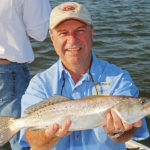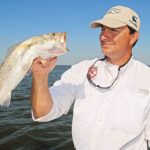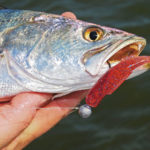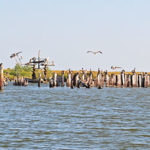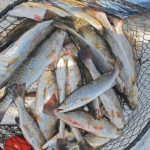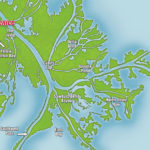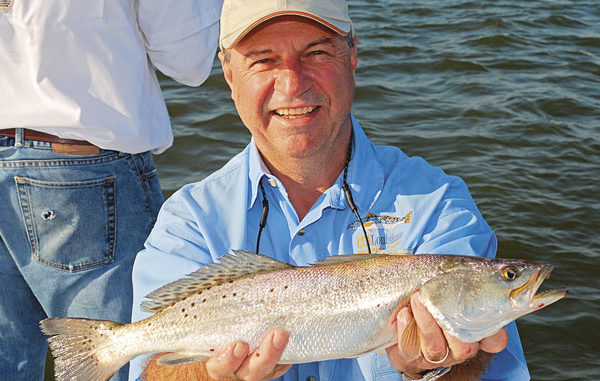
It just doesn’t get any easier than catching trout at Venice this time of year.
It was early October, and the soft light of dawn revealed that the Venice Marina harbor held as many orange-vested oil clean-up crewmen as sportfishermen.
But people had been catching fish — lots of fish.
Fishing partners David Cresson and Nelson “Snoop” Roth Jr. were ready. Both have an interest in fishing that goes beyond casual. Cresson is the executive director and CEO of the Louisiana branch of the Coastal Conservation Association (CCA).
Youthful at 39, he has the combined air of the boy next door and a life-long overachiever. He is competitive.
“I hate losing,” he confesses.
Roth, 53, has perhaps even more impressive CCA credentials. A member of the organization since 1997, he founded the Ascension Chapter, one of the largest in the state, in 2000, and served as its first president.
“We had our first meeting in an abandoned gas station,” he said with a grin.
From there he became a member of the state organization’s Management Committee, its nerve center, and in 2005-2006 served as its president. From 2008 on, he has been chairman of the CCA-Louisiana STAR Tournament.
The trip to Plaquemines Parish was scheduled on the spur of the moment, and Cresson was careful not to promise too much. Speckled trout, our quarry, would likely be in that in-between period when they are moving from their high-salinity summer habitats to interior marshes, and could be hard to locate.
Complicating the task of finding specks during the transition period would be the weather. The man was calling for it to blow 15 m.p.h. out of the north, not really vicious but enough to make the ride to Breton Island, where Cresson really wanted to fish, challenging.
The men left the marina with the rising sun a fiery orange blob barely peeking over the horizon. Cresson’s bay boat made short work of the run out Baptiste Collette Bayou to Breton Sound. It kept my eyelids peeled back and made my breath hard to catch.
As expected, the wind had the waters of Breton Sound disturbed. The ride was bouncy enough to make Roth hold on with both hands. Just when it was at its roughest, the water suddenly flattened out and a sliver of sand and vegetation appeared ahead. We were in the interior of the crescent-shaped island, what was once a much larger piece of real estate.
Cresson idled the boat to within 200 yards of a derelict wooden bulkhead, empty concrete slab and an old wellhead, footprints of man’s previous presence. He planned to let the wind drift the boat through the shallows until he found fish.
He didn’t have long to wait.
On his first cast, a spunky 16-inch speck grabbed the live shrimp drifting under his oval rattling cork. His next three casts produced the same results.
Cresson’s success left Roth muttering good-naturedly. Something with teeth had cut his rig off on his first cast.
On Cresson’s fifth cast, the speck pulled loose and Cresson scampered to the stern to spear the Cajun anchor into the bottom. Anchor set, both he and Roth returned to action, each catching three more speckled trout.
Then, nothing. Neither man could buy a fish. The anchor had been poorly set in the bottom and had pulled out, and the boat had drifted away from the feeding fish. After Roth retrieved the anchor, Cresson idled in a big circle to his original starting point and began the drift again.
Soon both men were peppering speckled trout from 13 to 19 inches long.
It was hard to imagine a prettier day. The wind that was a pest in the open waters of Breton Sound was cooling and welcome now. The celestial blue sky stretched from horizon to horizon, with only the occasional tiny cloud to blemish it.
The entire island was covered in birds, seeming thousands of pelicans, gulls and terns. More were in the skies. It was unimaginable that there could possibly have been more before the BP oil spill.
While he fished, Cresson talked about fishing the waters around Venice. Breton Island, he explained, is best from Memorial Day through September. But fishermen should be cautious and pay attention to the weather because of the long run across open water to get to it.
“Fish can be anywhere around Breton Island,” he explained. “One day they can be in the middle of the cove and the next day along the shoreline. Then the next day they will be on the other side of the island.”
Having and using a troll motor is helpful.
“Breton Island is actually my second favorite place to fish in Venice in the summer,” he said. “My favorite place is the block 69 rigs out of Pass a Loutre. I like Blind Bay and Custom House Bay too. The (speckled trout) are some of the biggest in the state.
“And the best fishing is yet to come. In November, as long as the Mississippi River at the New Orleans gauge is below 3 to 4 feet, you can fish for specks in the river itself, the Jump, Cubits Gap, the Southwest Pass spillways and Yellow Cotton Bay.
“Even though the summer is better for big trout, October and November are my favorite time of the year. Venice is paradise!
“When the river gets that low, there aren’t any secrets or science to fishing here. For a novice, ask at the marinas where to fish or simply look for the boats. If the trout are in The Jump, 50 boats will be lined up. If they are in Cubits Gap, there will be 25 boats. All the spots are marked on fishing maps too.
“You don’t have to be very good to catch fish in Venice then.”
Even though he admitted to often buying live bait in October and November, he said it is very seldom needed. Plastic baits on jigs are usually all that it takes.
“The real secret to fishing these places,” he explained, “is to use enough weight to get to the bottom. Some of the spots are deep and have a lot of current. I have had to use 2 ounces to get to the bottom in The Jump. If the jig head isn’t enough, add weight in front of it with split shot or egg sinkers.”
Lure selection in the fall is simple for Cresson.
“It’s hard to go wrong down here with purple/chartreuse Deadly Dudley Terror Tails or H&H Cocahoes,” he said. “Another good thing about Venice in October and November is that you can fish in almost all conditions, even after strong cold fronts. I used to fish Delacroix and Hopedale, but once I started fishing Venice, it was all over for any other place, even though the winter trout fishing in Delacroix is some of the best on the planet.”
Roth, who had been busy catching up with Cresson while he was talking, paused to punctuate his friend’s remarks.
“I really love fishing Venice,” he said. “I do it two or three times a year. I am more of an offshore fisherman, and have fished Costa Rica, Venezuela, Hawaii, the Bahamas, Guatemala and Mexico — Cabo, Cancun and Mazatlan — but I do love winter fishing for trout.”
The two men were really popping the trout, which were averaging about 16 inches long with an occasional 2½-pounder thrown in. They constantly had two flopping specks simultaneously beating out a tattoo on the boat’s deck. Roth caught up with Cresson on numbers. Cresson’s usually well-disguised competitive nature showed itself with his grimaces and sighs when he missed a fish.
Talk turned to the organization that Cresson works for and Roth loves.
“People often mistake CCA as the voice of the fishermen, but the organization really speaks for the fish,” said Cresson. “We are increasing our focus on the coastal erosion issue,” Cresson said, adding that CCA is also reaching out to kids because of the declining number of people fishing.
Another initiative that CCA Louisiana has undertaken is the establishment of saltwater fish hatcheries in the state.
But he emphasized that there are still lots of management issues.
“Our fishery is constantly under attack from government interests, environmental groups that don’t want us to fish and from people who are only interested in taking from the resource instead of putting back,” he said. “Our job is to make sure that the fish are well-taken care of.”
The fishing was a little too easy with live shrimp, so they rigged plastics on jig heads. Roth tied on a glow DOA shrimp under a cork. Cresson took his cork off and tight-lined his favorite, a purple/chartreuse Cocahoe. They both kept catching fish.
It seemed that they would limit out with 50 fish well before 10 a.m. Then, with 48 fish in the box, they mysteriously quit biting. Pterodactyl-like pelicans were still diving on all sides, some within 50 feet of the boat. Predator fish were slashing mullet and other small fish on the surface and gulls were picking off the panicked survivors. But neither man could get a bite.
Finally, Roth pulled anchor, and Cresson circled to the spot where their drift started, then moved over about 100 feet and turned the engine off. Before the boat drifted 50 feet, the last two soldiers were in the box and it was time to go. It was 10:32 a.m. Not bad for trout transition time.
Before he cranked up the big outboard, a satisfied Cresson looked out at the frantically diving birds and feeding predator fish, and said convincingly, “There is never an off time for Venice.”
